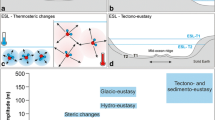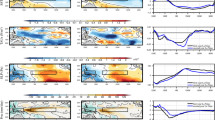Abstract
Recent studies point out the importance of northerly winds and waves in the Arabian Sea, especially those due to shamal and makran events in addition to the northeast monsoon system. We have analyzed climatology and trends of northerly maximum wind speed and significant wave height (Hs) in the Arabian Sea and the connected marginal seas, Arabian/Persian Gulf and the Red Sea, during non-monsoon season derived from 40 years of ERA5 wind and wave data, and estimated monthly, annual and decadal extreme climate and their trends. The study brings out an increasing trend in the northerly maximum wind speed (0.8–1.2 cm/s/year) and Hs (0.42–0.88 cm/year) in the southern and central Arabian Sea, which is consistent with the global trend in extreme wind speed and Hs. The northern Arabian Sea including the Sea of Oman exhibits significant decreasing trend in northerly maximum wind speed (− 1.4 cm/s/year) and Hs (− 0.67 cm/year), while the Gulf and the Red Sea exhibit sectorial contrasting trend, indicating the dominance of localized effects in modifying the regional climate. Distinct features identified in the climate and trends of northerly winds and waves are further discussed.










Similar content being viewed by others
Change history
08 February 2021
A Correction to this paper has been published: https://doi.org/10.1007/s00382-020-05581-z
References
Aarnes OJ, Abdalla S, Bidlot JR, Breivik Ø (2015) Marine wind and wave height trends at different ERA-interim forecast ranges. J Clim 28:819–837
Aboobacker VM, Shanas PR (2018a) The climatology of shamals in the Arabian Sea—part 1: surface winds. Int J Climatol 38:4405–4416
Aboobacker VM, Shanas PR (2018b) The climatology of shamals in the Arabian Sea—part 2: surface waves. Int J climatology 38:4417–4430
Aboobacker VM, Rashmi R, Vethamony P, Menon HB (2011a) On the dominance of pre-existing swells over wind seas along the west coast of India. Cont Shelf Res 31(16):1701–1712
Aboobacker VM, Vethamony P, Rashmi R (2011b) “Shamal” swells in the Arabian Sea and their influence along the west coast of India. Geophys Res Lett 38(3):L03608
Aboobacker VM, Seemanth M, Samiksha SV, Sudheesh K, Kerkar J, Vethamony P (2014) Sea breeze-induced wind sea growth in the central west coast of India. Ocean Eng 84:20–28
Aboobacker VM, Shanas PR, Alsaafani MA, Albarakaati AMA (2017) Wave energy resource assessment for Red Sea. Renew Energy 114:46–58
Anoop TR, Sanil Kumar V, Shanas PR, Johnson G (2015) Surface wave climatology and its variability in the North Indian Ocean based on ERA-Interim reanalysis. J Atmos Ocean Technol 32(7):1372–1385
Anoop TR, Shanas PR, Aboobacker VM, Sanil Kumar V, Nair LS, Prasad R, Reji S (2020) On the generation and propagation of Makran swells in the Arabian Sea. Int J Climatol 40(1):585–593
Bhaskaran PK, Gupta N, Dash MK (2014) Wind-wave climate projections for the Indian Ocean from satellite observations. J Mar Sci Res Dev S 11:005
Bruno MF, Molfetta MG, Totaro V, Mossa M (2020) Performance assessment of ERA5 wave data in a swell dominated region. J Mar Sci Eng 8:214. https://doi.org/10.3390/jmse8030214
Groves DG, Hunt LM (1980) Ocean world encyclopedia. McGraw-Hill, New York, p 443
Gupta N, Bhaskaran PK, Dash MK (2015) Recent trends in wind-wave climate for the Indian Ocean. Curr Sci 108(12):2191–2201
HersbachH BB, Berrisford P et al (2019) Global reanalysis: goodbye ERA-Interim, hello ERA5. ECMWF Newsl 159(2019):17–24
Hess A, Iyer H, Malm W (2001) Linear trend analysis: a comparison of methods. Atmos Environ 35:5211–5222
Hithin NK, Sanil Kumar V, Shanas PR (2015) Trends of wave height and period in the Central Arabian Sea from 1996 to 2012: a study based on satellite altimeter data. Ocean Eng 108:416–425
Kamranzad B (2018) Persian Gulf zone classification based on the wind and wave climate variability. Ocean Eng 169:604–635
Kendall M (1975) Rank correlation method, 4th edn. Charles Griffin, London, p 272
Kumar ED, Sannasiraj SA, Sundar V, Polnikov VG (2013) Wind-wave characteristics and climate variability in the Indian Ocean Region using altimeter data. Mar Geod 36:303–318
Langodan S, Cavaleri L, Viswanadhapalli Y, Hoteit I (2014) The Red Sea: a natural laboratory for wind and wave modelling. J Phys Oceanogr 44(2014):3139–3159
Langodan S, Cavaleri L, Pomaro A, Portilla J, Abulnaja Y, Hoteit I (2018) Unraveling climatic wind and wave trends in the Red Sea using wave spectra partitioning. J Clim 31:1881–1895
Li D, Anis A, Senafi AF (2020) Physical response of the Northern Arabian Gulf to winter shamals. J Mar Syst 203:103280
Liao YP, Kaihatu JM (2016) Numerical investigation of wind waves in the Persian Gulf: bathymetry effects. J Atmos Ocean Technol 33:17–31
Mahmoodi K, Ghassemi H, Razminia A (2019) Temporal and spatial characteristics of wave energy in the Persian Gulf based on the ERA5 reanalysis dataset. Energy 187:115991
Murakami H, Vecchi GA, Underwood S (2017) Increasing frequency of extremely severe cyclonic storms over the Arabian Sea. Nat Clim Change 7:885–889
Nair A, Das SS, Thomas A, Sarangi C, Kanawade VP (2019) Role of Cyclone “Ockhi” in the re-distribution of aerosols and its impact on the precipitation over the Arabian Sea. Atmos Res 235:104797
Naseef TM, Sanil Kumar V (2020) Climatology and trends of the Indian Ocean surface waves based on 39-year long ERA5 reanalysis data. Int J Climatol 40:979–1006
Parsons MJ, Crosby AR, Orelup L, Ferguson M, Cox AT (2018) Evaluation of ERA5 reanalysis wind forcing for use in ocean response modeling. In: Waves in shallow environments (WISE) conference, 22–26 Apr 2018, Tel Aviv, Israel
Ralston DK, Jiang H, Farrar JT (2013) Waves in the Red Sea: response to monsoonal and mountain gap winds. Cont Shelf Res 65:1–13
Rivas MB, Stoffelen A (2019) Characterizing ERA-Interim and ERA5 surface wind biases using ASCAT. Ocean Sci 15:831–852
Samiksha SV, Vethamony P, Aboobacker VM, Rashmi R (2012) Propagation of Atlantic Ocean swells in the north Indian Ocean: a case study. Nat Hazard Earth Syst 12:3605–3615
Sen PK (1968) Estimates of the regression coefficient based on Kendall”s Tau. J Am Stat Assoc 63:1379–1389
Senafi AF, Anis A (2015) Shamals and climate variability in the Northern Arabian/Persian Gulf from 1973 to 2012. Int J Climatol 35(15):4509–4528
Shamji VR, Aboobacker VM, Vineesh TC (2020) Extreme value analysis of wave climate around Farasan Islands, southern Red sea. Ocean Eng 207:107395
Shanas PR, Aboobacker VM, Albarakati AM, Khalid MZ (2017a) Superimposed wind-waves in the Red Sea. Ocean Eng 138:9–22
Shanas PR, Aboobacker VM, Albarakati AMA, Khalid MZ (2017b) Climate driven variability of wind-waves in the Red Sea. Ocean Model 119:105–117
Sreelakshmi SM, Bhaskaran PK (2020a) Regional wise characteristic study of significant wave height for the Indian Ocean. Clim Dyn 54:3405–3423
Sreelakshmi SM, Bhaskaran PK (2020b) Wind-generated wave climate variability in the Indian Ocean usingERA-5 dataset. Ocean Eng 209:107486
Stopa JE, Cheung KF (2014) Intercomparison of wind and wave data from the ECMWF Reanalysis Interim and the NCEP Climate Forecast System Reanalysis. Ocean Model 75:65–83
Thomson RE, Emery W (2014) Data analysis methods in physical oceanography, 3rd edn. Elsevier Science, Amsterdam ((ISBN: 9780123877833))
Vethamony P, Aboobacker VM, Menon HB, AshokKumar K, Cavaleri L (2011) Superimposition of windseas on pre-existing swells off Goa coast. J Mar Syst 87:47–54
Vinod Kumar K, Seemanth M, Vethamony P, Aboobacker VM (2014) On the spatial structure and time evolution of shamal winds over the Arabian Sea—a case study through numerical modelling. Int J Climatol 34(6):2122–2128
Wu J, Zha J, Zhao D, Yang Q (2018) Changes in terrestrial near-surface wind speed and their possible causes: an overview. Clim Dyn 51:2039–2078
Young IR, Ribal A (2019) Multiplatform evaluation of global trends in wind speed and wave height. Science 364:548–552
Yu Y, Notaro M, Kalashnikova OV, Garay MJ (2016) Climatology of summer Shamal wind in the Middle East. J Geophys Res Atmos 121:289–305
Zheng CW, Li CY (2017) Analysis of temporal and spatial characteristics of waves in the Indian Ocean based on ERA-40 wave reanalysis. Appl Ocean Res 63:217–228
Acknowledgements
We thank Prof. Hamad Al-Saad Al-Kuwari, Director, Environmental Science Center, Qatar University and Prof. Sunil K Singh, Director, National Institute of Oceanography, India for their constant encouragement and support. This work was jointly carried out under the IRCC International Research Co-Fund Collaboration Program of QU and NIO, executed through ORS, QU (IRCC-2019-002).
Funding
The project is funded under the IRCC International Research Co-Fund Collaboration Program of QU and NIO, executed through ORS, QU (IRCC-2019-002).
Author information
Authors and Affiliations
Contributions
VMA: monitoring the completion of the tasks assigned to the co-authors; managing discussions; analysis of the results; overall writing of the manuscript. PRS: data processing; generation of tables and figures; analysis of the results; manuscript writing. EMASA: data analysis, discussions and manuscript writing. VSK: data analysis, discussions and manuscript writing. PV: discussions and manuscript writing; correction and editing; lead project investigator of the funding project.
Corresponding author
Ethics declarations
Conflict of interest
No conflict of interest.
Availability of data and material
The data used in this study was obtained from the ECMWF data archive (https://www.cds.climate.copernicus.eu/#!/home). The processed data used in creating the plots will be made available to the Journal, upon request.
Code availability
Not applicable.
Additional information
Publisher's Note
Springer Nature remains neutral with regard to jurisdictional claims in published maps and institutional affiliations.
Rights and permissions
About this article
Cite this article
Aboobacker, V.M., Shanas, P.R., Al-Ansari, E.M.A.S. et al. The maxima in northerly wind speeds and wave heights over the Arabian Sea, the Arabian/Persian Gulf and the Red Sea derived from 40 years of ERA5 data. Clim Dyn 56, 1037–1052 (2021). https://doi.org/10.1007/s00382-020-05518-6
Received:
Accepted:
Published:
Issue Date:
DOI: https://doi.org/10.1007/s00382-020-05518-6




